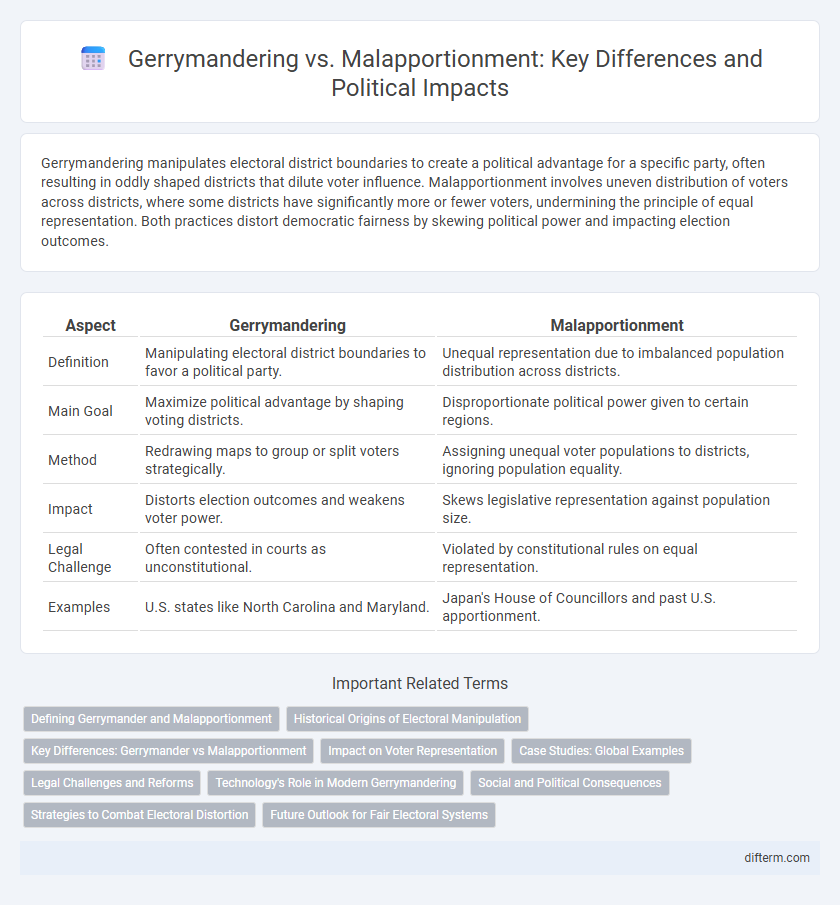Gerrymandering manipulates electoral district boundaries to create a political advantage for a specific party, often resulting in oddly shaped districts that dilute voter influence. Malapportionment involves uneven distribution of voters across districts, where some districts have significantly more or fewer voters, undermining the principle of equal representation. Both practices distort democratic fairness by skewing political power and impacting election outcomes.
Table of Comparison
| Aspect | Gerrymandering | Malapportionment |
|---|---|---|
| Definition | Manipulating electoral district boundaries to favor a political party. | Unequal representation due to imbalanced population distribution across districts. |
| Main Goal | Maximize political advantage by shaping voting districts. | Disproportionate political power given to certain regions. |
| Method | Redrawing maps to group or split voters strategically. | Assigning unequal voter populations to districts, ignoring population equality. |
| Impact | Distorts election outcomes and weakens voter power. | Skews legislative representation against population size. |
| Legal Challenge | Often contested in courts as unconstitutional. | Violated by constitutional rules on equal representation. |
| Examples | U.S. states like North Carolina and Maryland. | Japan's House of Councillors and past U.S. apportionment. |
Defining Gerrymander and Malapportionment
Gerrymandering is the deliberate manipulation of electoral district boundaries to favor a particular political party or group, often resulting in distorted representation. Malapportionment occurs when electoral districts have significantly unequal populations, leading to unequal representation where some votes carry more weight than others. Both practices undermine the principle of fair and equal representation in democratic systems.
Historical Origins of Electoral Manipulation
Gerrymandering originated in early 19th-century America, notably named after Massachusetts Governor Elbridge Gerry's 1812 redistricting plan designed to benefit his political allies by manipulating district boundaries. Malapportionment dates back even further, with roots in 18th-century British electoral practices where unequal population distribution across districts allowed overrepresentation of rural areas. Both practices represent historical strategies for political dominance, distorting representative democracy by either manipulating geographic boundaries or unevenly allocating voter populations.
Key Differences: Gerrymander vs Malapportionment
Gerrymandering involves the deliberate manipulation of electoral district boundaries to benefit a particular political party or group, often creating oddly shaped districts to concentrate or dilute voting power. Malapportionment refers to unequal representation in legislative bodies due to population imbalances among electoral districts, resulting in some votes carrying more weight than others. The key difference lies in intent and method: gerrymandering reshapes boundaries for partisan advantage, while malapportionment emerges from unequal district population distributions without deliberate boundary manipulation.
Impact on Voter Representation
Gerrymandering manipulates electoral district boundaries to favor specific political parties, resulting in distorted voter representation and diminished electoral competitiveness. Malapportionment creates unequal population distributions across districts, leading to inflated voting power in less populated areas and undermining the principle of equal representation. Both tactics disrupt democratic fairness by skewing how voter preferences translate into political power.
Case Studies: Global Examples
Gerrymandering and malapportionment are electoral manipulation techniques witnessed globally, with the United States exemplifying gerrymandering through partisan redistricting in states like North Carolina to secure political advantage. Japan's malapportionment case reveals significant vote value disparities between urban and rural districts, prompting Supreme Court challenges for constitutional conformity. In Australia, reforms targeting malapportionment in the state of Queensland have aimed to ensure equitable representation, contrasting with persistent gerrymandering debates in other democracies such as India.
Legal Challenges and Reforms
Legal challenges against gerrymandering often target the manipulation of district boundaries to dilute voter power, with courts scrutinizing partisan bias and racial discrimination in redistricting. Malapportionment disputes focus on equal representation, invoking the "one person, one vote" principle established in landmark rulings like Reynolds v. Sims. Reforms include independent redistricting commissions and stricter federal oversight to ensure fair district mapping and compliance with voting rights laws.
Technology's Role in Modern Gerrymandering
Advanced geographic information systems (GIS) and data analytics enable political actors to manipulate electoral boundaries with unprecedented precision, intensifying modern gerrymandering practices. Machine learning algorithms analyze voting patterns, demographic data, and social trends to create district maps that disproportionately favor specific parties or candidates. This technological evolution complicates efforts to ensure fair representation, blurring the lines between gerrymandering and malapportionment in contemporary politics.
Social and Political Consequences
Gerrymandering distorts electoral boundaries to favor specific political parties, undermining democratic representation and eroding public trust in the political system. Malapportionment creates unequal voter influence by allocating legislative seats disproportionately, leading to marginalized communities and skewed policy outcomes. Both practices exacerbate political polarization and hinder equitable social development by reinforcing entrenched power structures.
Strategies to Combat Electoral Distortion
Combating electoral distortion caused by gerrymandering and malapportionment requires the implementation of independent redistricting commissions that use algorithmic and data-driven approaches to create fair electoral boundaries. Legal frameworks enforcing population equality and transparency in district mapping processes help prevent manipulation of electoral districts. Civic engagement and real-time monitoring by watchdog organizations also play crucial roles in holding policymakers accountable and promoting equitable representation.
Future Outlook for Fair Electoral Systems
Emerging technologies like AI-driven redistricting software promise greater transparency and precision, reducing biases inherent in gerrymandering and malapportionment. Legal reforms that enforce independent boundary commissions are increasingly adopted worldwide to promote equitable representation. Enhanced public awareness and data analytics combined foster accountability, making future electoral systems more democratic and fair.
Gerrymander vs Malapportionment Infographic

 difterm.com
difterm.com